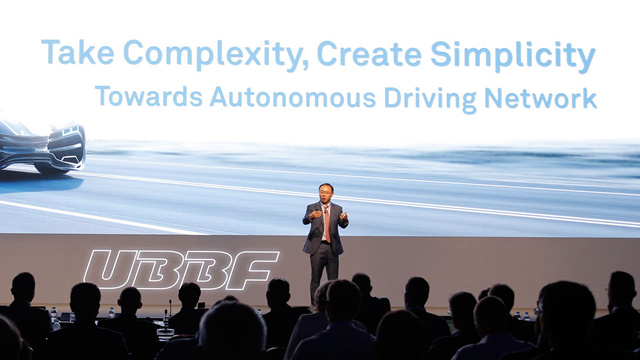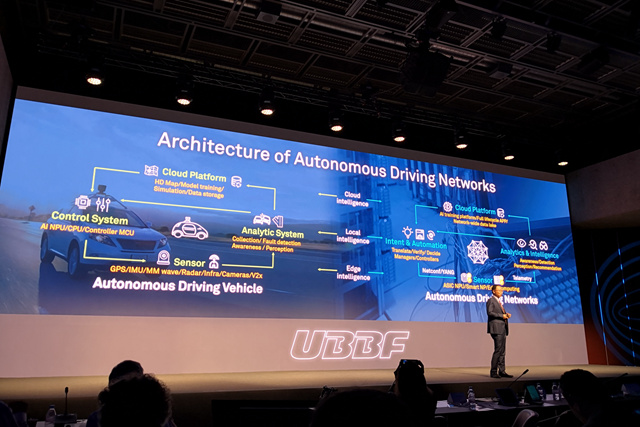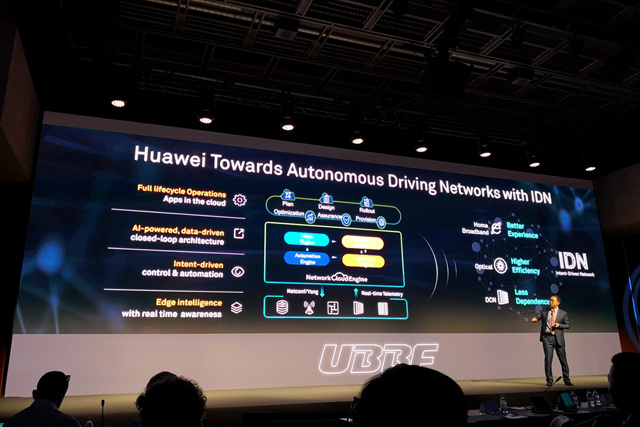|
华为汪涛:迈向自动驾驶网络时代 破局电信产业结构化问题-华为-48v通信高频直流开关电源华为汪涛:迈向自动驾驶网络时代 破局电信产业结构化问题-华为-48v通信高频直流开关电源北京时间9月11日下午消息(蒋均牧)“万物智能时代,自动驾驶正在从理想照进现实,汽车、飞机、制造等领域都在加快迈向自动驾驶的步伐,以进一步驱动产业的发展升级。而电信领域产业结构化问题突出,网络规模逐年增加,收入的增长落后于OPEX增长。相比OTT行业,电信网络运营维护对人员经验和技能依赖严重,电信网络走向自动驾驶迫在眉睫。”华为常务董事、产品与解决方案总裁汪涛在第五届全球超宽带高峰论坛(UBBF 2018)的主题演讲中表示。他代表华为提出了迈向自动驾驶网络的五级演进标准建议,阐述了如何将之落地实现的思路以及华为的创新探索。
当地时间9月10日上午9时,第五届全球超宽带高峰论坛在瑞士日内瓦开幕,以“智简网络最大化商业价值”为主线,围绕“品质宽带,重塑家庭业务体验”、“云网融合,使能B2B商业新增长”、“面向5G和云的城域网架构演进”和“迈向下一代全光网络”四大话题,分享智简网络的商业创新与实践。来自运营商、垂直行业领导者、监管机构、标准组织、媒体和第三方咨询机构的500多位行业精英出席了本次会议。 分场景逐步推进自动驾驶网络演进 人类追求先进生产力的脚步从不曾停歇。1947年,美国空军用C54完成了第一次横跨大西洋的全过程自动驾驶飞行的壮举;1983年,法国里尔地铁Métro de Lille启用,成为世界上第一条自动化的地铁路线;2012年,谷歌在内华达州获得世界上第一个无人驾驶的车辆许可,截至2018年3月总里程已经超过800万公里。每一次产业的变革都在驱动人类社会迈向新的发展纪元。 与汽车产业的自动驾驶不同,电信产业有其自身的复杂性。一张电信网络同时承载移动、家宽和企业等多种业务,自动驾驶系统需要准确理解不同业务的差异化意图;从自动驾驶的运行环境和路况角度来看,既有数据中心的“高速公路”,又有提供宽带接入的“城乡公路”,需要自动驾驶系统能适应跨多技术领域的复杂环境;从全生命周期运营的角度,规划、运维、业务发放等不同角色面临的挑战也各不相同。 有鉴于此,汪涛认为,面向自动驾驶网络的演进需要分场景逐步推进,并遵从三大原则——从网络OPEX的主要矛盾切入、从单领域到跨领域逐步形成闭环系统、以业务体验为中心自顶向下构建统一的数据模型和共享能力。 首提五级演进标准建议 自动驾驶网络不再是聚焦单个产品的创新,而是系统架构和商业模式的创新。因此华为呼吁产业共同定义清晰的标准来牵引技术创新并指导落地,并从业务体验和运营效率两个视角,突破性地提出电信行业迈向自动驾驶网络的五级演进标准。
落地实现思路及华为创新探索 当前的电信网络在走向自动驾驶过程中还存在网络状态看不清、运营维护系统割裂等诸多挑战,需要从架构和关键技术层面进行系统性思考和创新。 汪涛对此指出,首先需要在物理网络层构建一个能实时感知态势的边缘智能层,并大幅简化网络架构和协议;其次,通过统一建模构建数字孪生网络,从而实现全局态势的可回溯和可预测,基于AI实现预测性运维和主动闭环优化;最后,基于开放的云端平台实现AI算法训练和优化,并支撑规划、设计、业务发放、运维保障和网络优化等各类应用的敏捷开发,支撑全生命周期的自动化闭环运营。
目前,华为已经在自动驾驶网络领域展开了积极的创新探索,推出IDN等解决方案,涵盖宽带接入、IP、光网络、数据中心网络、企业专线连接等不同场景,帮助运营商和企业实现以业务体验为中心的数字化网络转型。与此同时,华为联合全球领先运营商共同发起了NetCity网络创新项目,共同定义商业场景,基于DevOps模式开展联合创新,实现前沿技术的快速导入。 “通向自动驾驶网络将是一个长期的旅程,是电信行业的诗和远方,需要产业各方共同努力、坚定前行。华为致力于把复杂留给自己,简单带给客户,共同拥抱万物互联的智能世界。”汪涛在发言的最后如是说道。 Beijing time September 11 afternoon news (Jiang Junmu) "All things intelligent era, automatic driving is from the ideal into reality, automobiles, aircraft, manufacturing and other fields are accelerating the pace of automatic driving, in order to further drive the development and upgrading of the industry. However, the industrial structure of the telecommunications industry is prominent, the network scale is increasing year by year, and the income growth lags behind the OPEX growth. Comparing with OTT industry, telecom network operation and maintenance rely heavily on personnel experience and skills, so it is imminent for telecom network to move towards automatic driving. Wang Tao, Huawei Managing Director and President of Products and Solutions, said in a keynote speech at the 5th Global UWB Summit Forum (UBBF 2018). On behalf of Huawei, he proposed a five-stage evolution standard proposal to move toward an automated driving network, elaborated on how to land it and Huawei's innovative exploration. The 5th Global Ultra-Wideband Summit Forum opened in Geneva, Switzerland at 9:00 a.m. local time on September 10. The main theme of the forum is "maximizing the commercial value of smart and simple networks". It centers on "quality broadband, remodeling the family business experience", "cloud convergence, enabling new B2B business growth" and "evolution of metropolitan area network architecture for 5G and cloud" And the four topics of the next generation of all optical networks, sharing the business innovation and practice of Chi Jian network. More than 500 industry elites from operators, vertical industry leaders, regulators, standards organizations, media and third-party advisory bodies attended the meeting. Gradual evolution of automatic driving network evolution The pace of human pursuit of advanced productive forces has never ceased. In 1947, the U.S. Air Force completed its first full-course automatic transatlantic flight with the C54; in 1983, the French Lille Metro opened, becoming the world's first automated subway line; in 2012, Google won the world's first unmanned vehicle license in Nevada, up to 20. In March 18, the total mileage has exceeded 8 million km. Every industry revolution is driving the development of human society towards a new era of development. Unlike the autopilot in the automotive industry, the telecommunications industry has its own complexity. A telecommunications network at the same time carries a variety of services such as mobile, home and business. The automatic driving system needs to accurately understand the differential intentions of different businesses. From the perspective of the operation environment and road conditions of automatic driving, there are both "freeway" in the data center and "urban and rural highway" providing broadband access, which needs automatic. Driving systems can adapt to complex environments across multi-technology domains; from the perspective of life-cycle operations, the challenges faced by different roles such as planning, operation and maintenance, and business delivery are also different. In view of this, Wang Tao believes that the evolution of the autopilot-oriented network needs to be progressed step by step in different scenarios and in accordance with three principles: starting from the main contradictions of network OPEX, gradually forming a closed-loop system from a single domain to a cross-domain, and building a unified data model and sharing capability from top to bottom centered on business experience. First proposed five level evolution criteria Autopilot networks are no longer focused on innovation in a single product, but on innovation in system architecture and business models. Therefore, Huawei calls on the industry to jointly define clear standards to tract technological innovation and guide landing, and from the business experience and operational efficiency of two perspectives, a breakthrough proposed telecommunications industry toward the five-level evolution of the automated driving network standards. L0: manual operation and maintenance, with auxiliary monitoring capabilities, all dynamic tasks depend on human execution. L1: Assist operation and maintenance, the system repeats a certain sub-task based on known rules to improve the execution efficiency of repetitive work. L2: Partial autonomous network, the system can be based on a certain external environment, a specific unit to achieve closed-loop operation and maintenance, reduce the personnel experience and skills requirements. L3: Conditional autonomous network, based on the ability of L2, the system can sense the change of environment in real time, dynamically optimize and adjust the external environment in a specific field, and realize intent-based closed-loop management. L4: A highly autonomous network. Based on L3's capabilities, the system can achieve predictive or proactive closed-loop management in more complex cross-domain environments for business and customer experience driven networks, solve problems earlier than customer complaints, reduce business interruptions and customer impact, and greatly improve customer satisfaction. L5: Completely autonomous network, this is the ultimate goal of the development of telecommunications network, the system has a cross-multi-service, cross-domain full life cycle of closed-loop automation capabilities, truly unmanned. Realization of landing and innovation exploration of HUAWEI At present, there are still many challenges such as unclear network status and fragmentation of operation and maintenance systems in the process of moving towards automatic driving in telecommunication networks, which require systematic thinking and innovation from the architecture and key technical aspects. Wang Tao pointed out that first of all, we need to build a real-time situation-aware edge intelligence layer in the physical network layer, and greatly simplify the network architecture and protocols; secondly, we need to build a digital twin network through unified modeling, so as to achieve the global situation traceability and predictability, and achieve predictive operation and maintenance and active closed-loop optimization based on AI. Finally, the AI algorithm training and optimization is realized based on the open cloud platform, and the agile development of various applications, such as planning, design, service delivery, operation and maintenance support and network optimization, is supported to support the automatic closed-loop operation of the whole life cycle. At present, Huawei has launched active innovative explorations in the field of autopilot networks, introducing IDN and other solutions, covering broadband access, IP, optical networks, data center networks, enterprise dedicated lines, etc. 华为通信电源,华为电源官网,华为高频开关电源,华为-48v开关电源,华为开关电源模块,华为网络机柜,华为服务器机柜,华为室外一体化机柜,华为OLT电源,华为直流电源,华为开关电源,华为综合柜,华为UPS,UPS5000-E,UPS2000-A,UPS2000-G,UPS8000-D,UPS5000-A,华为TP48200,华为TP48300,华为TP48600 |




